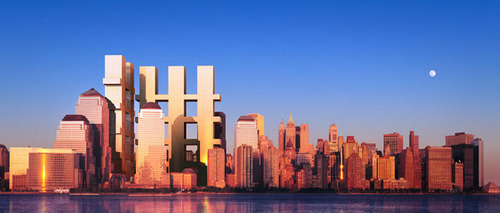 That guy on the left isn't at all. He's Dan Bartlett, flak for the Architect of the Axis of Evil (and, alarmingly, the most straight-talking guy on the show) image: charlierose.com
That guy on the left isn't at all. He's Dan Bartlett, flak for the Architect of the Axis of Evil (and, alarmingly, the most straight-talking guy on the show) image: charlierose.comJust caught The WTC "Dream Team" (their quotes)--Charles Gwathmey, Peter Eisenman, Steven Holl, and Richard Meier --on Charlie Rose. [thanks for the headsup, archinect!] Preceded by an interview with White House Communications Director Dan Bartlett, Rose apparently chose obfuscation as tonight's theme.
It was a lot of serious-minded awe eliciting empty comments about massive publicity ("How do you deal with being so great, old friend?"), one seemingly unintended admission, and an easy-to-miss editing mystery. (A coverup? If it were a coverup, I'm sure Charlie "60 Minutes2" Rose'd be on it, not in it...) What went basically unsaid (because unasked) was a discussion of the Dream Team's actual dream. (Check the Day After the unveiling, where the connection between their grid/tower concept and the wrecked shards of the original towers is made clear.)
I am very unsettled by this team's refusal to discuss what seems to be the guiding principle of their design.
 Gwathmey: "It's haunting...eerie"
Meier: "ix-nay on the aunting-hay, uck-Chay"
image: LMDC
Gwathmey: "It's haunting...eerie"
Meier: "ix-nay on the aunting-hay, uck-Chay"
image: LMDCStill, Charles Gwathmey came really close when he talked about how their plan addresses New York at both levels, "the pedestrian plane" (! Plane?) and the "sky plane." (!! Two planes?) He said, "It's haunting. It's an eerie speculation about memory and presence. The image is incredibly powerful." Gwathmey's reference to the skyline rules out the possibility he was discussing the declared memorial aspect of their plan: street-level gardens in the shape of the Twin Towers' shadows, which extend across the World Financial Center and into the Hudson.
There was no articulation of what this image is or why, no discussion of the form, no followup, no discussion about (this) memorial. Eisenman quoted Adolf Loos (again, also here, in relation to his Memorial to the Murdered Jews of Europe), "The work of architecture is monuments and graves, and in other words, the work of memory." Even if I like their concept of a monumental shard taking over the downtown skyline (and I have to admit, it's quite powerful), their conscious avoidance of expressing or acknowledging their clear intent is arrogant, verging on deceitful.
The surreal TV moment: a minute or so later, there's a jump cut; something was obviously excised from the conversation. While Eisenman is talking next to him, an anxious Meier is slowly trying to drop some folded papers from view, and all the while he's sending intense messages across the table with his eyes. To whom? According to that basic element of continuity editing, eyeline matching, it was Charles Gwathmey.












